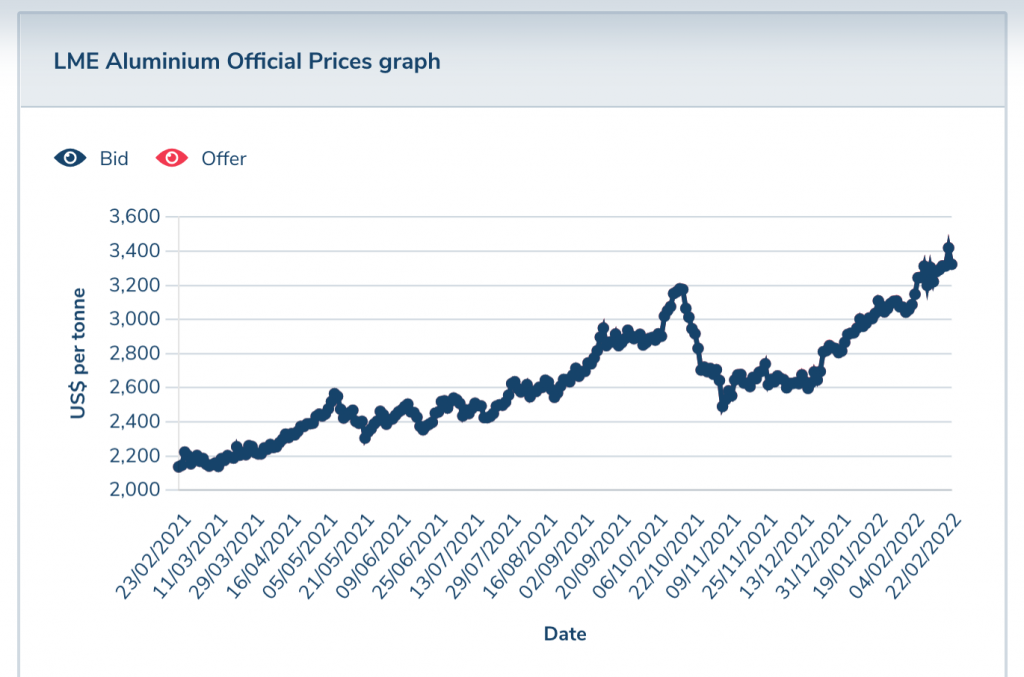By Alberto Gross, Co-Founder, and CEO @ Luminium Coin – Feb 28, 2022
Over the past 12 months, the spot price of P1020 aluminum (high-grade aluminum deliverable against the most liquid futures contracts in the world) has risen 55%. This is quite a remarkable feat given that just 2 years prior, at all the aluminum conferences being held around the world, the mood of attendees was decidedly gloomy. Industry executives lamented the sea of aluminum in which the world was awash, which necessitated the costly reduction of capacity and lower sales prices. Now, the mood is decidedly different, as many manufacturers wonder if they will be able to obtain all the aluminum they need to do business.
Here in Florida, orders from distribution centers that used to be delivered in 3 weeks are now taking as long as 5 months. It is estimated for the first time in several years that in 2022 the imbalance between supply and demand is decidedly on the side of insufficient supply.

So what has happened in the last 2 years to reverse the market’s mood? And how will these market forces resolve themselves in the coming year?
The first thing that happened was COVID and the transportation problems that it caused. The world is a very connected place. And one of the primary enablers of that connectivity is the global transportation network: the planes, the trucks, and the cargo ships. Due to lockdowns, this entire network was restricted, slowing the movement of goods.
In fact, with fewer flights connecting London and New York, a squeeze occurred in the COMEX gold market’s physical deliveries that nearly forced the futures market to transition to financial – as opposed to physical – settlements.
Much of the economy was able to endure the supply delays because the lockdowns caused demand to plummet. However, once the world started opening back up, the transportation network could not increase capacity fast enough to deal with skyrocketing demand.
This was particularly important in the U.S. since 10% to 20% of the aluminum produced in the world gets consumed in the U.S., and it is mostly imported from other countries, such as China and Canada. With transportation not operating efficiently, MidWest premiums (the markup for primary aluminum traded on U.S. soil) skyrocketed, and still trade at record highs now in early 2022. This problem was made worse by the U.S.’s trade barriers to aluminum (such as tariffs, etc.) which were established when markets were oversupplied and the U.S. aluminum markets were being protected from dumping by China.
At the Harbor Aluminum Symposium in Chicago in September 2021, the price of aluminum stood at $2,600. The keynote speaker gave himself credit for predicting that aluminum would rise to that level when most other analytical firms predicted much lower prices. What was this speaker’s prognostication for the future? Given that growth in the global economy would not be as torrid from that point forward, and that in 2022 much new capacity would be brought online, he did not think the fundamentals were great for continued increases in the price. In February 2022, the price of aluminum stands at over $3,300. So, what did this very knowledgeable speaker miss?
First, the price of energy. Far more dramatic than the price of aluminum in the post-pandemic economy, has been the price of crude oil. At the start of the pandemic, crude oil futures traded below $0 since, at some delivery points, where crude oil supply exceeded storage capacity and producers were paying the market to take their crude so that they could avoid hefty storage fees. Compare that to crude oil at $100 almost two years later as the market panics because of Russia’s invasion of Ukraine.
Energy is the lifeblood of the global economy, and a subset of that market – electricity – is the lifeblood of aluminum production. Higher electricity costs do not necessarily pass through to the selling price of aluminum. However, when electricity in Europe rises so high that it is no longer economical to run a smelter. And when China can’t import enough coal to power its grid. You get significant decreases in aluminum supply. And that forces prices higher.
How bad are imbalances at the moment? So bad, in fact, that the U.S. pointedly announced that Rusal (the big Russian aluminum company) would be excluded from any sanctions leveled against Russia. Cutting off Russian aluminum would punish the global economy far more than it would punish Russia. This tells us two things:
- The market for aluminum at the moment is extremely tight.
- Aluminum is a crucially important commodity for global industry.
What does the future hold?
In a free-market economy, shortages and high price increases create the incentive for producers to ramp up production. And this is happening. However, aluminum capacity is not easy to expand. It will take between 6 and 9 months for capacity increases to come online to balance supply and demand. In the meantime, tighter monetary policy resulting in a slower world economy is expected to dampen demand.
It is likely that inflation will remain high over the next few years in that the money supply is still growing faster than the increases in goods and services – and there is often up to a two-year lag between changes in monetary policy and inflation. Despite the fact that aluminum supply and demand will move towards balance, the price of aluminum will likely remain high because of continued increases in energy and transportation costs.
